More and more suppliers are also using the term “climate neutrality” to advertise their products on the promotional products market and are compensating for the greenhouse gas emissions caused by financing climate protection projects. An effective method in the urgent battle against global warming – even if the way some companies and brands over-advertise their commitment is sometimes slightly irritating. What “climate neutral” doesn’t mean, why products are (hitherto) less frequently certified as companies and how hangtags can provide transparency.

If sustainability is one of the social, political and economic trends of our era, “climate neutrality” is no doubt one of the most hotly-debated themes within that trend. Everyone is talking about it, even at the highest political level: For example, the EU wants to become the first continent to become climate neutral by 2050. That sounds good, but what does it actually mean? As so often, also in the case of the term “climate neutrality” the barriers between a precise definition and a mere buzzword are blurred. A standardisation project initiated by the British Standardisation Institute in 2019 is to provide a solution here: The planned norm ISO 14068 “Greenhouse gas management and related activities – Carbon Neutrality” is to lay down requirements and principles that are to be proven when claiming greenhouse gas, carbon or climate neutrality. The international standardisation work began in September 2020 and involves the cooperation of national mirror committees of diverse EU states. The ISO norm, the aim of which is to clarify and define generally recognised terms, is to come into effect at the end of 2023.
An example from Germany demonstrates how necessary such a definition is: The announcement in May by the Central Agency for the Prevention of Unfair Competition that it intended to take legal action among others against the discounter Aldi Süd for their misleading use of the term “climate neutral” caused a major stir in the media. The discounter claims among others to be “the first climate neutral food retailer. According to own accounts, the Central Agency for the Prevention of Unfair Competition is the largest and most influential nationallyoperating, self-regulating institution in terms of implementing Germany’s laws on unfair competition. The fact that a lawsuit had been filed against Aldi and on top of that for their usage of the current buzzword in the field of sustainability – was covered by virtually all of the daily newspapers and national media and also sparked off a wide debate on firstly how climate neutrality should be evaluated and secondly how it should be advertised.
Basically, the protectors of competition law aimed to explain what “climate neutral” actually means and what the consumer ultimately understands it to be. However, a certain amount of scepticism was expressed regarding the method applied since the climate neutrality was “merely a mathematical result” that is achieved by “purchasing CO2 compensation certificates” – in some cases without making the production processes eco-friendlier.

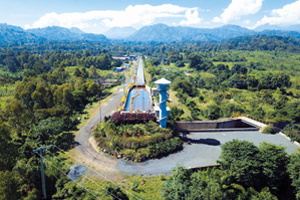
This argumentation drives people like Estelle Herlyn crazy. The Professor at the Competence Centre for Sustainable Development at the FOM College of Economics and Management reacted to the actions of the Central Agency for the Prevention of Unfair Competition with a guest article that was published in several media. The world needs lots more companies like Aldi Süd, the sustainability expert stated and there are plenty of people, who share her opinion. She added that climate neutrality is a term that is firmly established in the political debate, which is always based on a balance calculation. The Federal Government, the EU, the members of the Paris Agreement on Climate Protection – had all committed themselves to climate neutrality, fully aware that “it is practically impossible to realise a liveable civilisation for billions of people without causing emissions.” Additional entrepreneurial commitment is urgently needed because the political measures don’t suffice by far to achieve the goal of a maximum increase in the global warming of 2 °C, ideally 1.5 °C,” explained Herlyn. And all of the projects supported by Aldi in Brazil, Ghana, India and the Philippines make their contribution towards combatting the climate change.
The discussion that was and is not only held among experts reveals a dilemma: Many companies want to do something in the fight against climate change, but many are not sure what the right approach is. “Climate neutrality” is a central term of this issue, but due to its inflationary usage, its significance is becoming blurred in a sea of vagueness. If Aldi’s sneakers are as equally climate neutral as the veggie line or the chicken of other food retails or the id4 SUV of VW, is that a good sign because the brands have finally understood that they have to change something? Or does it just save them from having to think about their own processes in depth? Does it help the climate, does it help us all, does it help the people in emerging and developing countries? Or is it all merely a huge bluff, greenwashing in its purest form? Similar questions arise on the marketing front: Does climate neutrality have a positive impact on the sustainability strategy of the promoted brand? Does that bring any advantages? Or the other way round: Is a future possible without it?
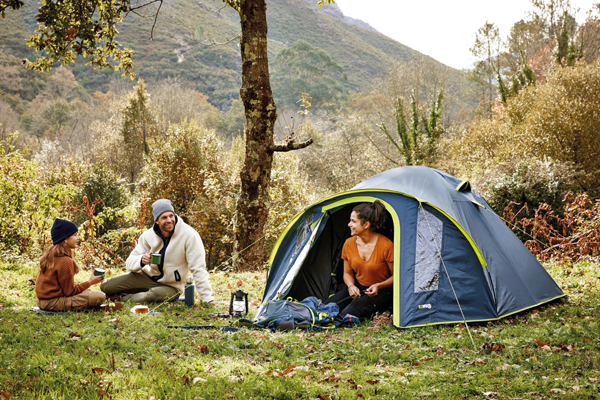
Climate neutrality is becoming increasingly important and a matter of course in the field of haptic advertising. One of the most recent examples: Together with the Swiss outdoor brand Rewind, the premium provider Boost has developed a loyalty campaign for Coop Switzerland, in which the climate neutral products underline the love of experiencing nature.
Standards instead of advertising claims
Anyone, who occupies himself with climate neutrality on the haptic advertising market, quickly realises: The term is just as omnipresent here as on the retail market. For example, Manfred Janek has observed that “climate neutrality has become an all-in tool in the promotional products industry.” Janek has been the Sustainability Officer at the Swiss/Austrian promotional products agency, KW Open, for many years and additionally founded the company Ecobrands, which exclusively sells decidedly sustainable products – such as natural fertiliser made from horse dung, Sprout pencils that can be planted or the Danish glass drinking bottles of Retap. He is not happy about the promotional overexploitation of products that are branded as being “climate neutral”. “Sometimes one gets the impression this dispels all of our fears. Basically, climate neutrality is not a bad thing. Certification companies organise positive projects for the environment for a relatively low fee. They are a good way of at least partially compensating for the damage caused.” But this mustn’t be the only environmental activity on the haptic advertising market, according to Janek: “We can’t simply carry on as before polluting the environment with throw-away items from unknown sources made from bad materials that are often also produced under questionable working conditions. If we do, there’s no use planting trees in Africa afterwards or trying to buy one’s way out with some other favourablypriced pseudo activity. That simply doesn’t add up for any brand.”
Rolf Janka, Managing Director and CSR Officer of the Munich-based promotional products agency, Hagemann, agrees with him. “Climate neutrality is no longer a USP. Companies all over are using the label climate neutrality in their advertising measures, the perception of the differences is becoming very blurred, our customers are partly totally confused.” Sometimes the transport or the packaging is promoted as being climate neutral, sometimes the company, but seldom the products themselves. “Whereby climate neutral dispatch is really nothing special today. The standards according to which the CO2 emissions are calculated and compensated vary too, as do the prices. So one has to take a close look to see which suppliers are really making an effort to make their processes more environmentallyfriendly along the supply chain.”
One person, who occupies himself with the theme climate neutrality every day and who know exactly what is meant by the specific terms because it is his job, is Peider Bach, Head of Customer Success Germany at ClimatePartner. Like NatureOffice or the non-profit making organisation myClimate, the company ClimatePartner, which was founded 15 years ago, specialises in supporting companies in the battle against the climate change and with more than 5,000 customers worldwide is considered to be the market leader among the certification bodies. Their activities include five focal points: Determining the carbon footprint of companies or their products, introducing measures for the reduction of emissions, compensating for the remaining emissions by supporting climate protection projects and supporting the communication about the projects and achievements. “Some of the phrases used are quite rightly criticised,” remarked Bach, “because they aim predominantly to have a promotional impact, but in fact are basically over-exaggerations.” As is the case with the existence of a pregnancy, where there is no grey zone, a product or a company is either climate neutral or not – however the statement of it being “100% climate neutral” arouses the impression that there are more inferior classifications. “It is also factually incorrect to label one’s products as being carbon-free or CO2-free, because that would mean that no CO2 is emitted during the production process, which is unrealistic at present,” continued Bach, who is eager that the communications of ClimatePartner customers are clear and not ambiguous. “Claims have to be true. Transparency is extremely important.”
Which is why in the meantime the company has its own extensive marketing department, whose main task is to support customers in communicating their climate activities to the public in an emphatic, yet factually correct manner. After all, the many cases of exaggerated or incorrect usage of the term “climate neutrality” lead to doubts arising regarding the concept itself. According to own accounts, the Central Agency for the Prevention of Unfair Competition also felt itself obliged to take legal action due to the many enquiries from confused citizens.
Wherever
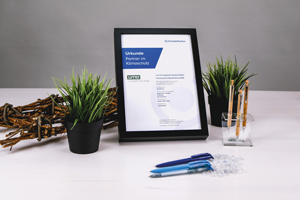
It is important that products are made climate-neutral, not just the company. More and more providers in the haptic advertising market have at least parts of their ranges certified as being climate-neutral, including the writing instrument specialist, uma.
In order to ensure transparency, first of all the term has to be explained. A basic problem here lies in the terminus technicus itself. “Climate neutrality” doesn’t actually mean – as is frequently misunderstood – that a company brings a priori particularly eco or climate-friendly product onto the market. In fact, climate neutrality means that unavoidable greenhouse gas emissions are compensated for elsewhere, namely by financially supporting climate protection projects around the globe. As such, the criticism of the organisation foodwatch that awarded the negative prize “Windbag of the Year 2021” to the chicken meat of the Rewe brand, Wilhelm Brandenburger, that was labelled as being climate neutral was not actually justified. The consumer protection body found it brazen to “promote meat of all things as being a climate protector”. However, the label “climate neutral” doesn’t actually say anything about the climate-friendliness of the chicken itself – i.e. compared to pea-based vegan alternatives.
It seems much more important, as foodwatch did in this particular case, to question the processes behind the respective labels. Serious certification companies consistently implement monitorable standards. At ClimatePartner for instance one is striving to standardise everything, regarding both the calculation of the emissions as well as concerning the compensation projects. The bag specialist, Halfar, which has made its complete line-up of promotional bags climate neutral, is also a customer of ClimatePartner. The bags are furnished with hangtags, which via QR codes and ID tracking, convey how much CO2 was emitted and compensated for and which projects are supported. For example, Halfar supports two long-term projects in the countries, where bags are manufactured: The reforestation of a coast to the west of Peking and the construction of a solar park in India.
The question is often posed as to why the climate protection projects are carried out in emerging and developing countries rather than in the local regions where the companies obtaining the certifications are based. There is a simple explanation for this. Because all member states of the Paris Agreement have committed themselves to allocate national budget to finance climate protection projects in their own countries, certification companies like ClimatePartner focus on projects in the poorer, southern regions of the world so as not to promote measures that are already receiving support. From a purely physical point of view, it doesn’t make any difference where CO2 emissions are reduced in the world. Also the allegation that companies consciously support climate protection projects in locations that are less expensive can be easily refuted. A lot more can be achieved for the climate for the same amount of money by backing projects in development countries rather than in the industrial north – and ultimately the goal is to achieve as much as possible. Incidentally, in practice the climate neutral products are not much more expensive than those for which the emissions are not compensated for, which significantly increases their acceptance from a buyer’s point of view.
Avoid or compensate
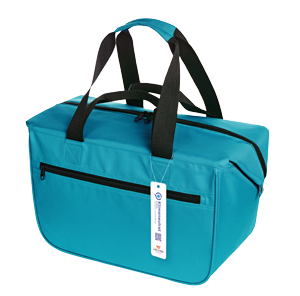
The bag specialist Halfar has made all of his promotional bags climate neutral. Via an ID tracking link on the hangtag, recipients can access information about how much CO2 is compensated and what projects are promoted.
But, of course, the question remains as to whether the climate change couldn’t be more effectively combatted if more was invested in changing the production processes and thus reducing the emissions from the onset. “Rather than subsequently making products climate neutral retrospectively, it would be better to think the production development chain right through to the disposal, i.e. in the form that one manufactures products following the cradle-to-cradle principle or tries to modernise the production to reduce the CO2 emissions,” suggested Janek. “We need the label ‘Climate neutrality’ to reach our climate goals, but this alone will not suffice.” In his argumentation he makes reference to the calculations of diverse experts: If the Paris Agreement didn’t exist, in order to achieve the goal of +2°C global warming the CO2 emissions would have to be reduced by 1,000 billion tons in the case of uncurbed development. Around 500 billion tons are saved through political measures, around 250 billion tons through negative emissions (i.e. compensations through climate protection projects). A surplus of 250 billion tons remains, which can only be bridged by dispensing with processes and products that emit CO2. And the hourglass keeps on running relentlessly.
This is precisely why the ClimatePartner employee Bach considers climate neutrality to be an “important step towards holistic climate protection, because if we want to reach the Paris goals, we only still have eight or nine years. So, we can’t wait for a technological solution, which wouldn’t be scalable or implementable anyway. We have no choice but to compensate for the emissions caused elsewhere.” “Of course, it would be nicer if we were able to manufacture things where – to over-exaggerate – oxygen comes out of the chimneys instead or greenhouse gases,” added Halfar’s Managing Director and founder, Armin Halfar. “But that isn’t possible. Insofar compensations are an important step in the right direction to obtain climate neutrality. And the projects we support are direct measures in the battle against global warming. If a coal-fired power plant can be switched off in India one day, because the corresponding photovoltaic plants have been built, that is definitely going to have a positive impact on the climate. But obviously it is of no great help if companies only compensate for emissions to become climate neutral and use this as a label to advertise their products without changing any of their other processes and merely carry on working the same way as 25 years ago. That doesn’t bring much benefit at all,” the bag specialist agreed.
Hence, climate neutrality is not the be all and end all, but it is indispensable, especially since it provides a low-threshold starting point for a more detailed confrontation with a sustainability strategy. Bach knows from his own experiences: “Most of our companies kick off with a corporate balance. Then, the process of grappling with the overall theme starts, which often leads to further measures in the second or third year, such as compensating for products, product groups or line-ups.”
Products, products, products
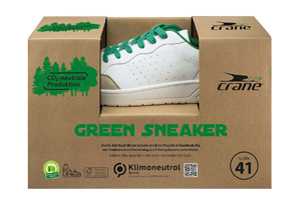
th advertising messages on the subject of climate neutrality, the German discounter Aldi prompted the Central Agency for the Prevention of Unfair Competition to take action. These sneakers were also among the products advertised as climate neutral.
Whereby having a product certified as being climate neutral is much more laborious than having a company certified. Whereas in the latter case fossil fuels rather than parameters such as for instance the energy requirement of the production, the further electric consumption, the vehicle fleet, the employee’s journeys to work, business trips, the water consumption or the volume of waste have to be calculated, all of the raw materials, initial processes and the logistics of the upstream chain come into the equation for the product.
The bag specialist Halfar didn’t let itself be put off by this and has made its entire line-up of promotional bags climate neutral. “This is going to become the standard anyway in three to four years’ time,” assumed Armin Halfar. “We are striving to push this development and position ourselves as one of the pioneers, after all our locations and transport routes have been climate neutral for some time already.” Climate neutrality is thus not an additionally bookable option at Halfar, it is indeed obligatory. Ultimately, those customers, who don’t opt for the more environmentally-friendly model, i.e. for the compensation of climate-polluting greenhouse gases, shouldn’t be rewarded with more favourable- prices.
Janka’s employer, the advertising agency Hagemann, has had itself certified as a climate neutral company as well. “That is no major deal for distributors,” Janka explained. However the fact “that the products are climate neutral” is indeed much more decisive than an own certification as a climate neutral firm.” It is not only the more detailed process; it also offers promoting companies the opportunity to directly label the presented gift as being climate neutral. This has a much more direct impact than taking the detour of being mentioned as a climate neutral company involved in the procurement process. With its website nachhaltige-werbegeschenke. de, Hagemann has created an online point of contact for decidedly eco-friendly promotional products, which are classified according to various sustainability criteria. The rubric “climate neutral products” currently contains just under 150 articles, from a lunchbox made of glass, to an induction charging station made of recycled ABS, through to a metal graphite pen or FairTrade chocolate. Janka is convinced the demand for such items will grow. “The pressure on the companies to act will increase. Especially the big brands are frightened about shitstorms and are being observed by NGOs. Even if it doesn’t interest the people themselves, the competitive pressure is forcing them to address the theme.” Bach too believes, “Over the coming years, not being active on the climate protection front is going to become a competitive disadvantage.” And Halfar added: “The professional buyers of brand-name companies specifically ask about the sustainability criteria of a product, know what they want and are well-informed about the topic. It is important that the promotional products trade is fully informed so it can offer accurate advice.”
Janka predicts that all of this will lead to even more climate neutral promotional products within a few years,” especially since it is, in principle, very easy to achieve the status of climate neutrality. “It is going to be exciting whether and to what extent further differentiations are made based on further criteria and for instance whether the CO2 emissions are calculated for the total life cycle.” Because once again: Climate neutrality is not the only decisive characteristic in combatting global warming, it is just one of many important measures. And as important as it may be, paying attention to the climate footprint when purchasing promotional products doesn’t suffice alone: “The holistic climate protection strategy plays a decisive role. It is no good companies distributing promotional pens that are produced in a climate neutral manner, if they don’t pursue the same goal themselves. That doesn’t convey a credible image,” stated Bach, whose company has launched an initiative together with the agencies Mediaplus and Serviceplan, which determines the impact communication measures as a whole have on the climate. Using a software solution the emissions of entire genres – from the TV spot to the advertising poster – can be determined and ultimately compensated for. For example, ARD Media recently made all of its radio and TV spots climate neutral in the scope of the Green-GRP Initiative.
But haptic advertising does have one advantage over all other advertising measures: It not only claims to be climate-friendly; it ideally also offers the direct proof. “Promotional products often don’t take the front seat in the case of big brands,” Janka reported, “but they offer them the opportunity to underline their sustainability strategy in haptic form and to show what position they take in the areas of climate neutrality or recycling. An item has to fit in with the respective sustainability strategy.” If it does, it has the best chance of leaving a sustainable impression behind and of preventing possible irritations from even arising at all.
// Dr. Mischa Delbrouck
Photos: Aldi Süd, climateparnter.com/1072 (2), Halfar, Pandinavia, Prominate UK; Sahm, uma





